University Nursing: Teaching Plan for Sputum Collection Procedure
VerifiedAdded on 2022/08/21
|10
|2082
|27
Practical Assignment
AI Summary
This assignment presents a comprehensive peer teaching plan for sputum collection, designed for nursing students. The plan outlines the lesson objectives, session duration, and required resources. It details a step-by-step procedure, including patient preparation, decontamination, specimen collection, labeling, and documentation. The plan emphasizes the importance of effective communication, patient privacy, and the use of deep coughs to obtain accurate samples. An evaluation section describes the methods used to assess student understanding, including feedback, questionnaires, and observation of practices. The evaluation aims to identify areas for improvement in the teaching plan and ensure that students can accurately perform the sputum collection procedure. The assignment highlights the significance of proper sputum collection for diagnosing diseases like tuberculosis and pneumonia, emphasizing the need for accurate and timely laboratory analysis. The document showcases group collaboration and the use of online tools for communication and feedback. The plan stresses the importance of proper technique and hygiene to prevent contamination and ensure accurate results. Finally, the teaching plan is followed by an evaluation plan to test the expected outcomes of the teaching lesson plan, which plays a crucial role in ensuring the learning outcomes of peer student nurses.
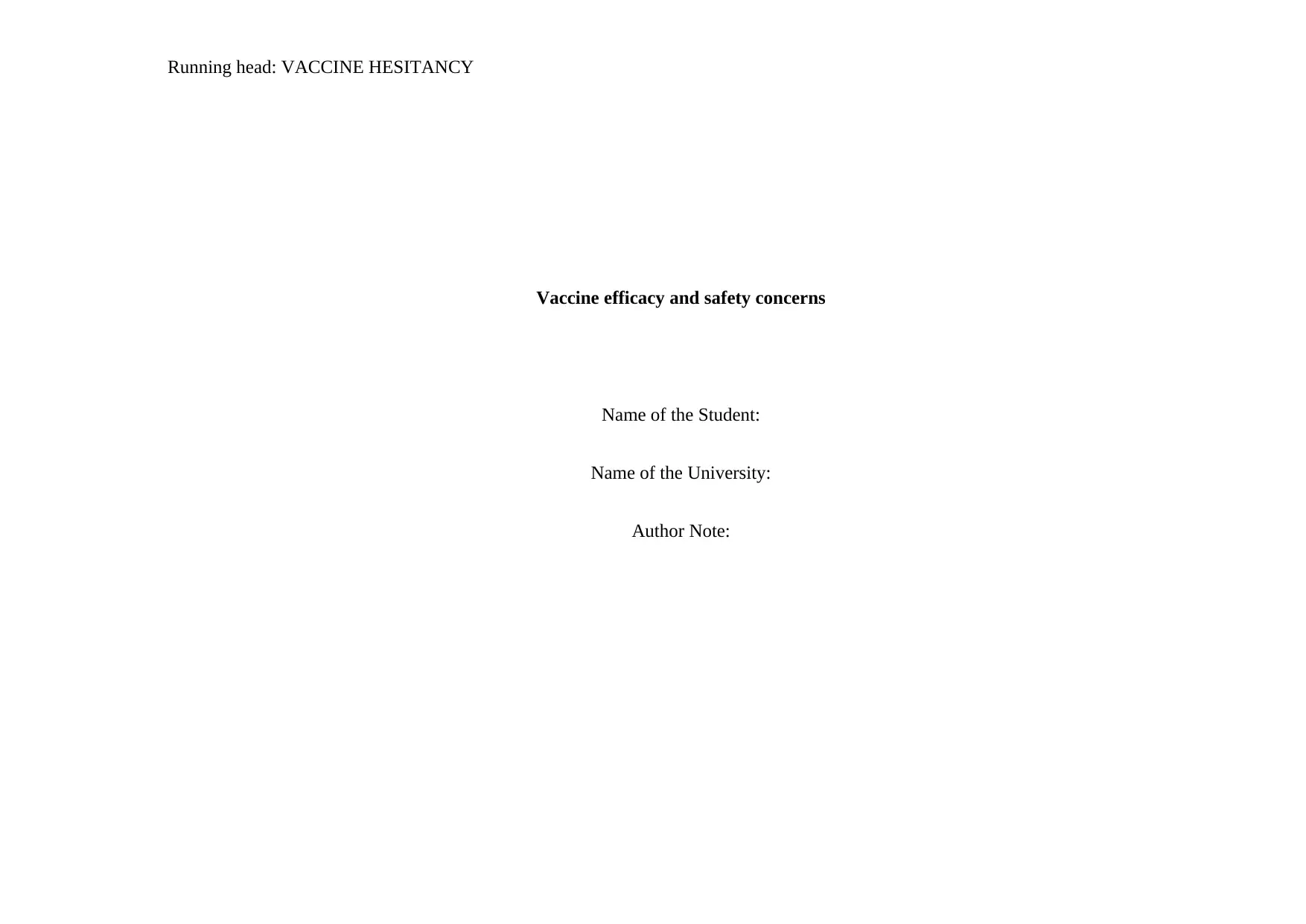
Running head: VACCINE HESITANCY
Vaccine efficacy and safety concerns
Name of the Student:
Name of the University:
Author Note:
Vaccine efficacy and safety concerns
Name of the Student:
Name of the University:
Author Note:
Paraphrase This Document
Need a fresh take? Get an instant paraphrase of this document with our AI Paraphraser
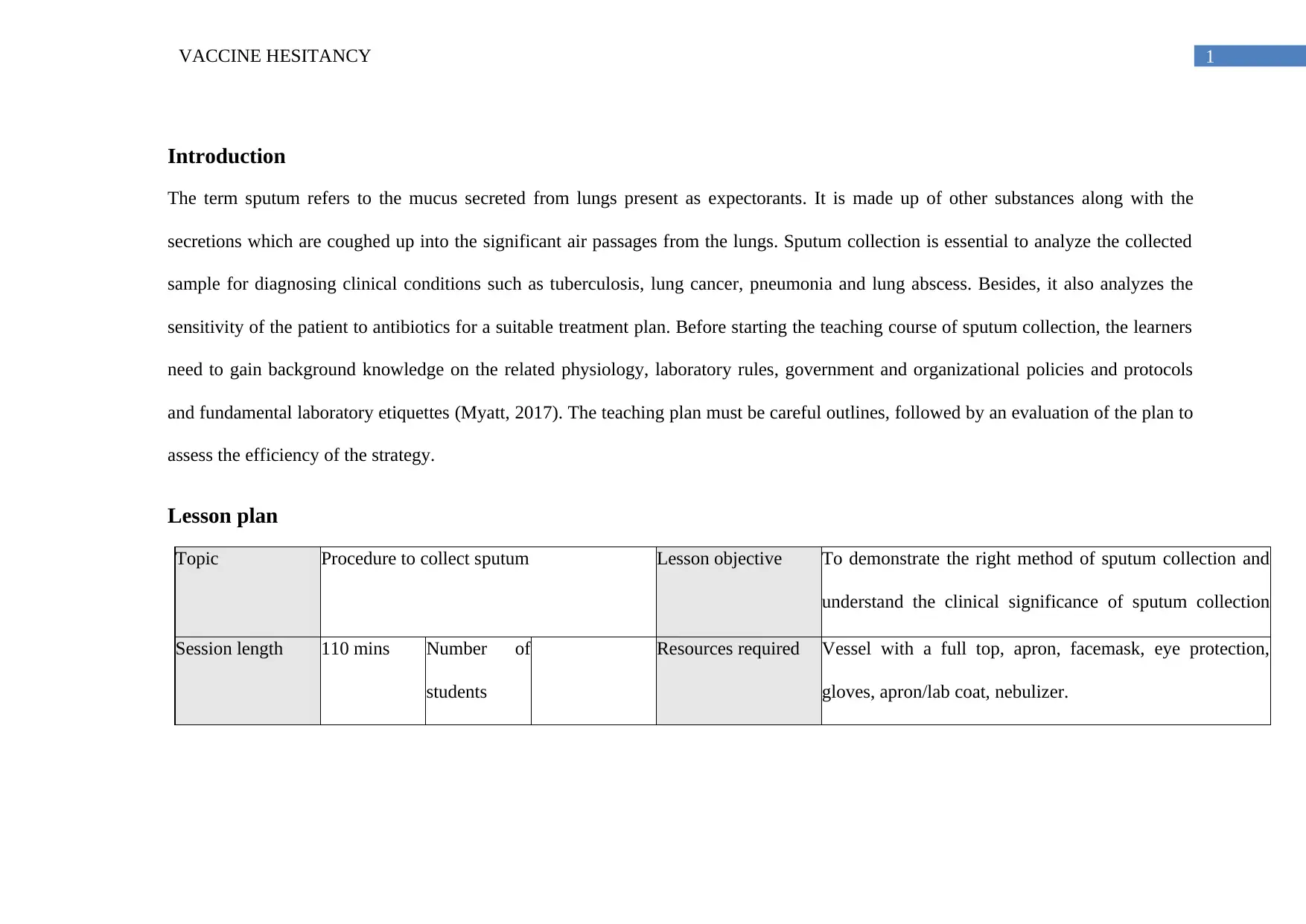
1VACCINE HESITANCY
Introduction
The term sputum refers to the mucus secreted from lungs present as expectorants. It is made up of other substances along with the
secretions which are coughed up into the significant air passages from the lungs. Sputum collection is essential to analyze the collected
sample for diagnosing clinical conditions such as tuberculosis, lung cancer, pneumonia and lung abscess. Besides, it also analyzes the
sensitivity of the patient to antibiotics for a suitable treatment plan. Before starting the teaching course of sputum collection, the learners
need to gain background knowledge on the related physiology, laboratory rules, government and organizational policies and protocols
and fundamental laboratory etiquettes (Myatt, 2017). The teaching plan must be careful outlines, followed by an evaluation of the plan to
assess the efficiency of the strategy.
Lesson plan
Topic Procedure to collect sputum Lesson objective To demonstrate the right method of sputum collection and
understand the clinical significance of sputum collection
and analysis.Session length 110 mins Number of
students
Resources required Vessel with a full top, apron, facemask, eye protection,
gloves, apron/lab coat, nebulizer.
Introduction
The term sputum refers to the mucus secreted from lungs present as expectorants. It is made up of other substances along with the
secretions which are coughed up into the significant air passages from the lungs. Sputum collection is essential to analyze the collected
sample for diagnosing clinical conditions such as tuberculosis, lung cancer, pneumonia and lung abscess. Besides, it also analyzes the
sensitivity of the patient to antibiotics for a suitable treatment plan. Before starting the teaching course of sputum collection, the learners
need to gain background knowledge on the related physiology, laboratory rules, government and organizational policies and protocols
and fundamental laboratory etiquettes (Myatt, 2017). The teaching plan must be careful outlines, followed by an evaluation of the plan to
assess the efficiency of the strategy.
Lesson plan
Topic Procedure to collect sputum Lesson objective To demonstrate the right method of sputum collection and
understand the clinical significance of sputum collection
and analysis.Session length 110 mins Number of
students
Resources required Vessel with a full top, apron, facemask, eye protection,
gloves, apron/lab coat, nebulizer.
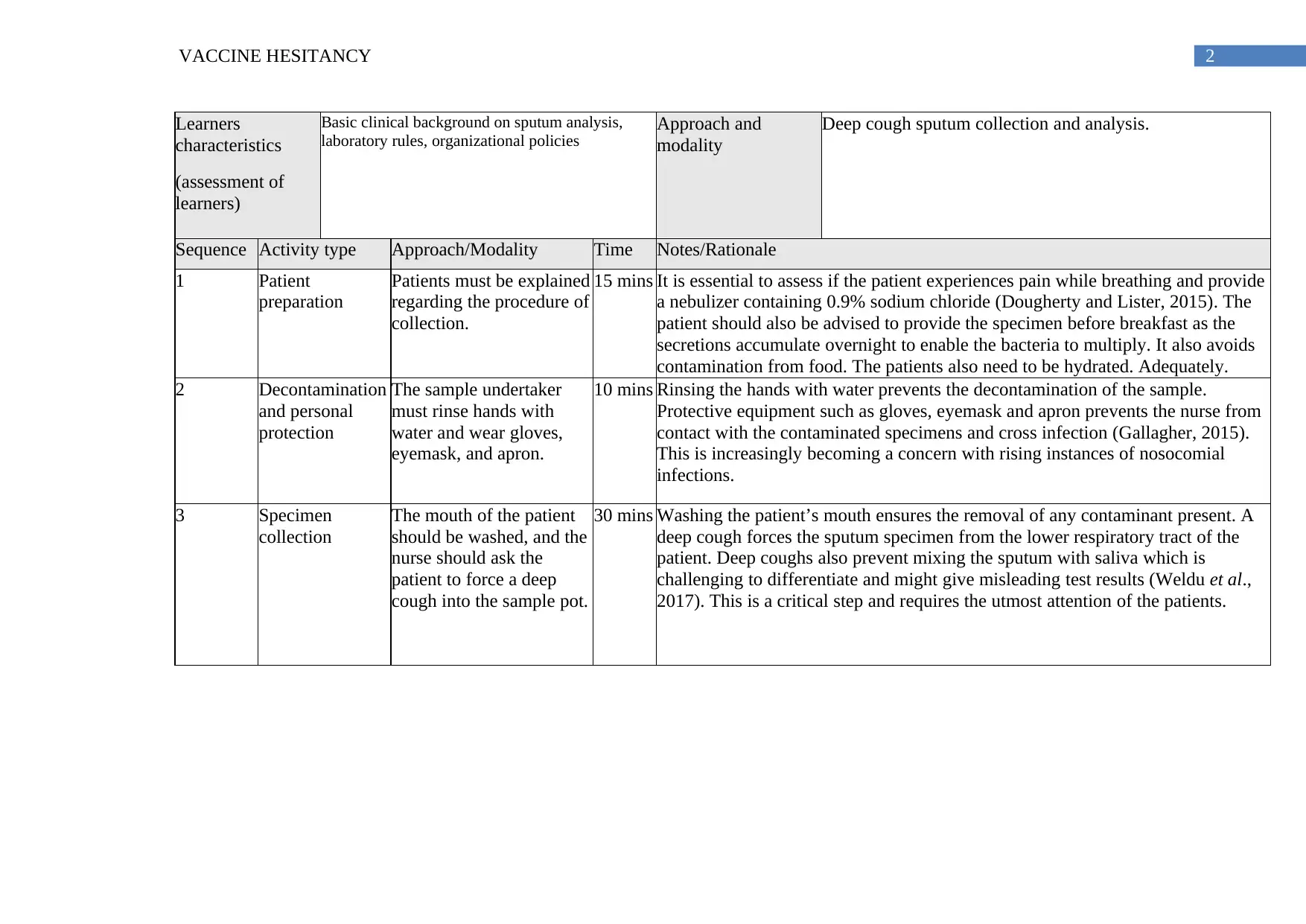
2VACCINE HESITANCY
Learners
characteristics
(assessment of
learners)
Basic clinical background on sputum analysis,
laboratory rules, organizational policies
Approach and
modality
Deep cough sputum collection and analysis.
Sequence Activity type Approach/Modality Time Notes/Rationale
1 Patient
preparation
Patients must be explained
regarding the procedure of
collection.
15 mins It is essential to assess if the patient experiences pain while breathing and provide
a nebulizer containing 0.9% sodium chloride (Dougherty and Lister, 2015). The
patient should also be advised to provide the specimen before breakfast as the
secretions accumulate overnight to enable the bacteria to multiply. It also avoids
contamination from food. The patients also need to be hydrated. Adequately.
2 Decontamination
and personal
protection
The sample undertaker
must rinse hands with
water and wear gloves,
eyemask, and apron.
10 mins Rinsing the hands with water prevents the decontamination of the sample.
Protective equipment such as gloves, eyemask and apron prevents the nurse from
contact with the contaminated specimens and cross infection (Gallagher, 2015).
This is increasingly becoming a concern with rising instances of nosocomial
infections.
3 Specimen
collection
The mouth of the patient
should be washed, and the
nurse should ask the
patient to force a deep
cough into the sample pot.
30 mins Washing the patient’s mouth ensures the removal of any contaminant present. A
deep cough forces the sputum specimen from the lower respiratory tract of the
patient. Deep coughs also prevent mixing the sputum with saliva which is
challenging to differentiate and might give misleading test results (Weldu et al.,
2017). This is a critical step and requires the utmost attention of the patients.
Learners
characteristics
(assessment of
learners)
Basic clinical background on sputum analysis,
laboratory rules, organizational policies
Approach and
modality
Deep cough sputum collection and analysis.
Sequence Activity type Approach/Modality Time Notes/Rationale
1 Patient
preparation
Patients must be explained
regarding the procedure of
collection.
15 mins It is essential to assess if the patient experiences pain while breathing and provide
a nebulizer containing 0.9% sodium chloride (Dougherty and Lister, 2015). The
patient should also be advised to provide the specimen before breakfast as the
secretions accumulate overnight to enable the bacteria to multiply. It also avoids
contamination from food. The patients also need to be hydrated. Adequately.
2 Decontamination
and personal
protection
The sample undertaker
must rinse hands with
water and wear gloves,
eyemask, and apron.
10 mins Rinsing the hands with water prevents the decontamination of the sample.
Protective equipment such as gloves, eyemask and apron prevents the nurse from
contact with the contaminated specimens and cross infection (Gallagher, 2015).
This is increasingly becoming a concern with rising instances of nosocomial
infections.
3 Specimen
collection
The mouth of the patient
should be washed, and the
nurse should ask the
patient to force a deep
cough into the sample pot.
30 mins Washing the patient’s mouth ensures the removal of any contaminant present. A
deep cough forces the sputum specimen from the lower respiratory tract of the
patient. Deep coughs also prevent mixing the sputum with saliva which is
challenging to differentiate and might give misleading test results (Weldu et al.,
2017). This is a critical step and requires the utmost attention of the patients.
⊘ This is a preview!⊘
Do you want full access?
Subscribe today to unlock all pages.

Trusted by 1+ million students worldwide
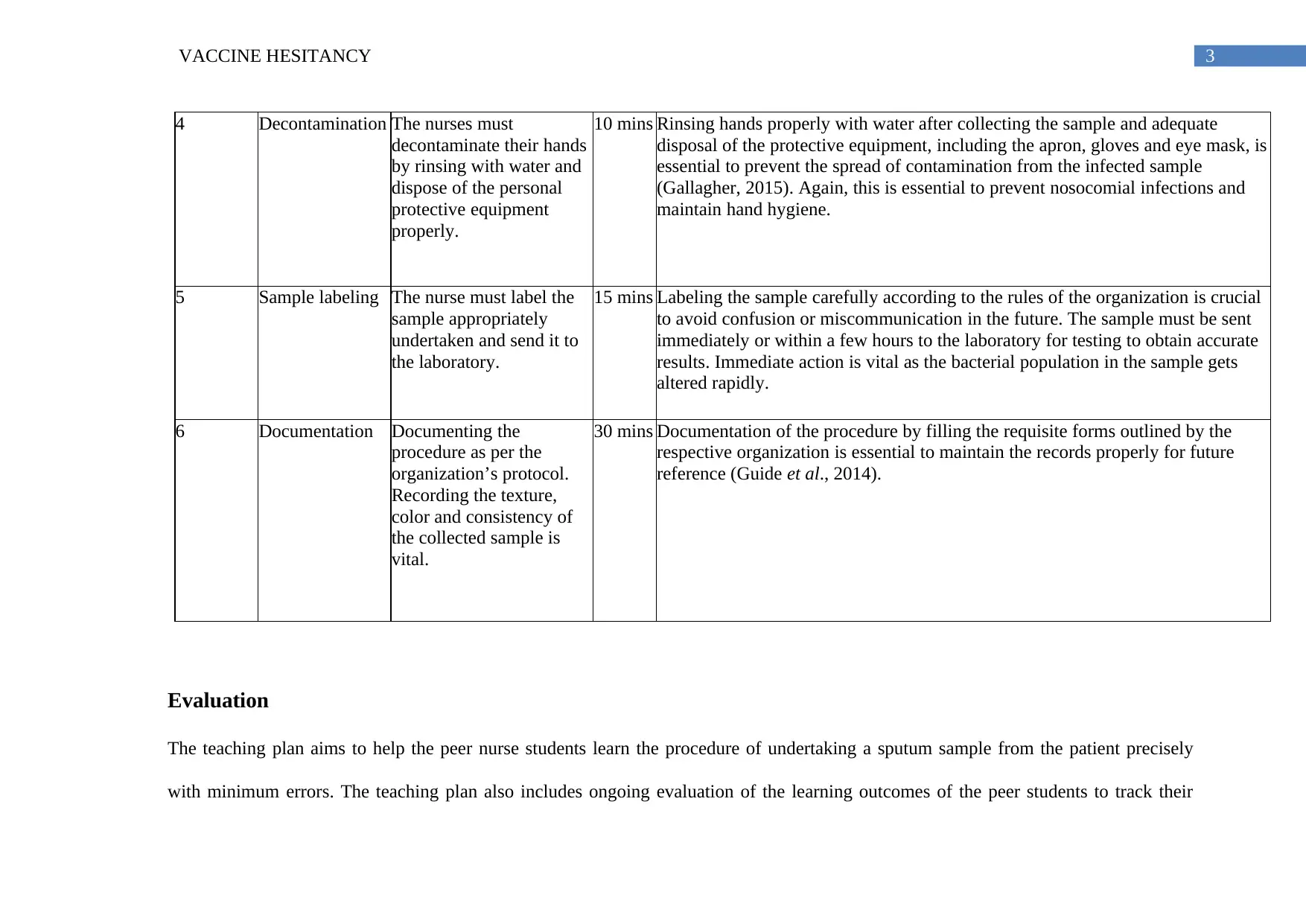
3VACCINE HESITANCY
4 Decontamination The nurses must
decontaminate their hands
by rinsing with water and
dispose of the personal
protective equipment
properly.
10 mins Rinsing hands properly with water after collecting the sample and adequate
disposal of the protective equipment, including the apron, gloves and eye mask, is
essential to prevent the spread of contamination from the infected sample
(Gallagher, 2015). Again, this is essential to prevent nosocomial infections and
maintain hand hygiene.
5 Sample labeling The nurse must label the
sample appropriately
undertaken and send it to
the laboratory.
15 mins Labeling the sample carefully according to the rules of the organization is crucial
to avoid confusion or miscommunication in the future. The sample must be sent
immediately or within a few hours to the laboratory for testing to obtain accurate
results. Immediate action is vital as the bacterial population in the sample gets
altered rapidly.
6 Documentation Documenting the
procedure as per the
organization’s protocol.
Recording the texture,
color and consistency of
the collected sample is
vital.
30 mins Documentation of the procedure by filling the requisite forms outlined by the
respective organization is essential to maintain the records properly for future
reference (Guide et al., 2014).
Evaluation
The teaching plan aims to help the peer nurse students learn the procedure of undertaking a sputum sample from the patient precisely
with minimum errors. The teaching plan also includes ongoing evaluation of the learning outcomes of the peer students to track their
4 Decontamination The nurses must
decontaminate their hands
by rinsing with water and
dispose of the personal
protective equipment
properly.
10 mins Rinsing hands properly with water after collecting the sample and adequate
disposal of the protective equipment, including the apron, gloves and eye mask, is
essential to prevent the spread of contamination from the infected sample
(Gallagher, 2015). Again, this is essential to prevent nosocomial infections and
maintain hand hygiene.
5 Sample labeling The nurse must label the
sample appropriately
undertaken and send it to
the laboratory.
15 mins Labeling the sample carefully according to the rules of the organization is crucial
to avoid confusion or miscommunication in the future. The sample must be sent
immediately or within a few hours to the laboratory for testing to obtain accurate
results. Immediate action is vital as the bacterial population in the sample gets
altered rapidly.
6 Documentation Documenting the
procedure as per the
organization’s protocol.
Recording the texture,
color and consistency of
the collected sample is
vital.
30 mins Documentation of the procedure by filling the requisite forms outlined by the
respective organization is essential to maintain the records properly for future
reference (Guide et al., 2014).
Evaluation
The teaching plan aims to help the peer nurse students learn the procedure of undertaking a sputum sample from the patient precisely
with minimum errors. The teaching plan also includes ongoing evaluation of the learning outcomes of the peer students to track their
Paraphrase This Document
Need a fresh take? Get an instant paraphrase of this document with our AI Paraphraser
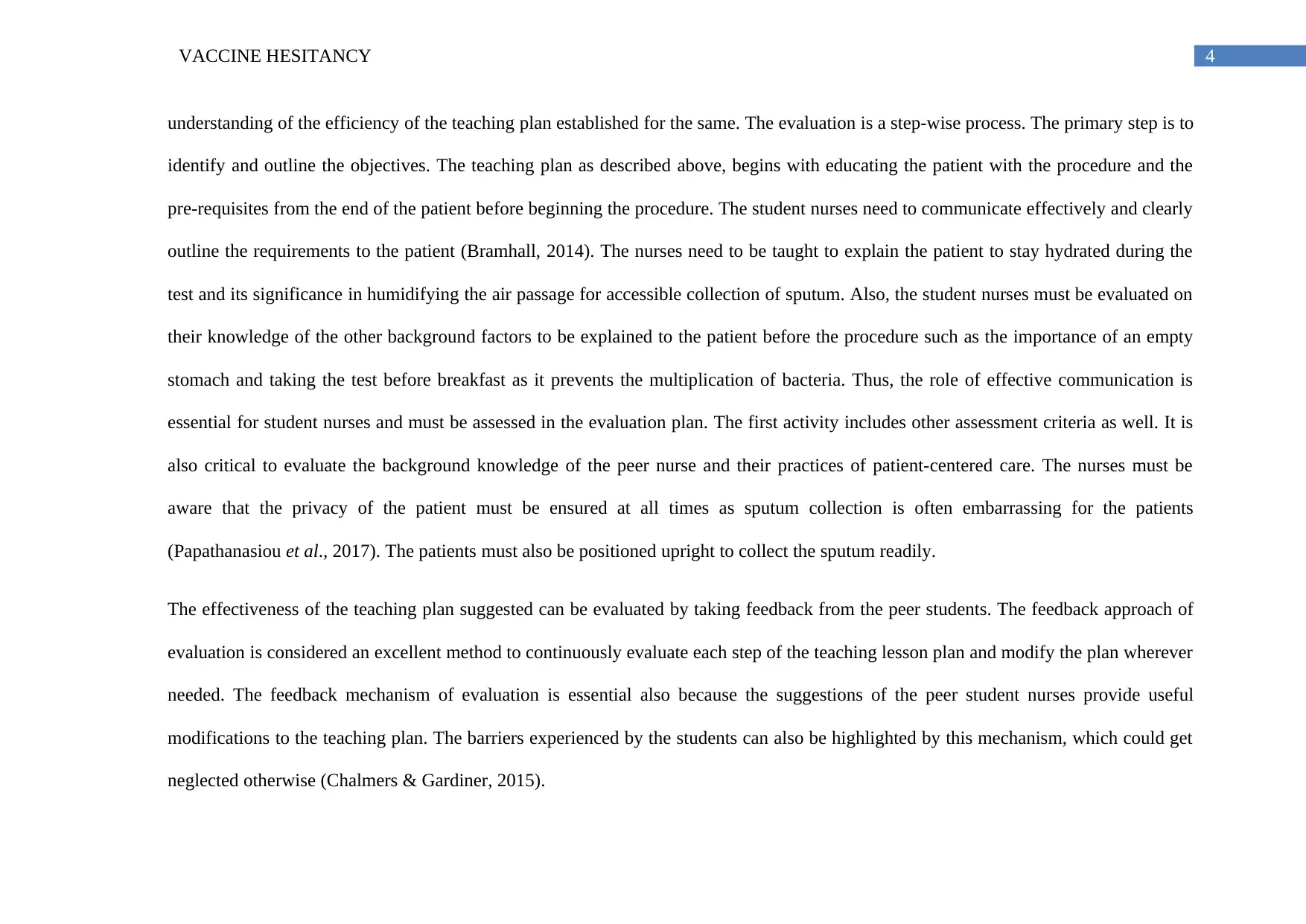
4VACCINE HESITANCY
understanding of the efficiency of the teaching plan established for the same. The evaluation is a step-wise process. The primary step is to
identify and outline the objectives. The teaching plan as described above, begins with educating the patient with the procedure and the
pre-requisites from the end of the patient before beginning the procedure. The student nurses need to communicate effectively and clearly
outline the requirements to the patient (Bramhall, 2014). The nurses need to be taught to explain the patient to stay hydrated during the
test and its significance in humidifying the air passage for accessible collection of sputum. Also, the student nurses must be evaluated on
their knowledge of the other background factors to be explained to the patient before the procedure such as the importance of an empty
stomach and taking the test before breakfast as it prevents the multiplication of bacteria. Thus, the role of effective communication is
essential for student nurses and must be assessed in the evaluation plan. The first activity includes other assessment criteria as well. It is
also critical to evaluate the background knowledge of the peer nurse and their practices of patient-centered care. The nurses must be
aware that the privacy of the patient must be ensured at all times as sputum collection is often embarrassing for the patients
(Papathanasiou et al., 2017). The patients must also be positioned upright to collect the sputum readily.
The effectiveness of the teaching plan suggested can be evaluated by taking feedback from the peer students. The feedback approach of
evaluation is considered an excellent method to continuously evaluate each step of the teaching lesson plan and modify the plan wherever
needed. The feedback mechanism of evaluation is essential also because the suggestions of the peer student nurses provide useful
modifications to the teaching plan. The barriers experienced by the students can also be highlighted by this mechanism, which could get
neglected otherwise (Chalmers & Gardiner, 2015).
understanding of the efficiency of the teaching plan established for the same. The evaluation is a step-wise process. The primary step is to
identify and outline the objectives. The teaching plan as described above, begins with educating the patient with the procedure and the
pre-requisites from the end of the patient before beginning the procedure. The student nurses need to communicate effectively and clearly
outline the requirements to the patient (Bramhall, 2014). The nurses need to be taught to explain the patient to stay hydrated during the
test and its significance in humidifying the air passage for accessible collection of sputum. Also, the student nurses must be evaluated on
their knowledge of the other background factors to be explained to the patient before the procedure such as the importance of an empty
stomach and taking the test before breakfast as it prevents the multiplication of bacteria. Thus, the role of effective communication is
essential for student nurses and must be assessed in the evaluation plan. The first activity includes other assessment criteria as well. It is
also critical to evaluate the background knowledge of the peer nurse and their practices of patient-centered care. The nurses must be
aware that the privacy of the patient must be ensured at all times as sputum collection is often embarrassing for the patients
(Papathanasiou et al., 2017). The patients must also be positioned upright to collect the sputum readily.
The effectiveness of the teaching plan suggested can be evaluated by taking feedback from the peer students. The feedback approach of
evaluation is considered an excellent method to continuously evaluate each step of the teaching lesson plan and modify the plan wherever
needed. The feedback mechanism of evaluation is essential also because the suggestions of the peer student nurses provide useful
modifications to the teaching plan. The barriers experienced by the students can also be highlighted by this mechanism, which could get
neglected otherwise (Chalmers & Gardiner, 2015).
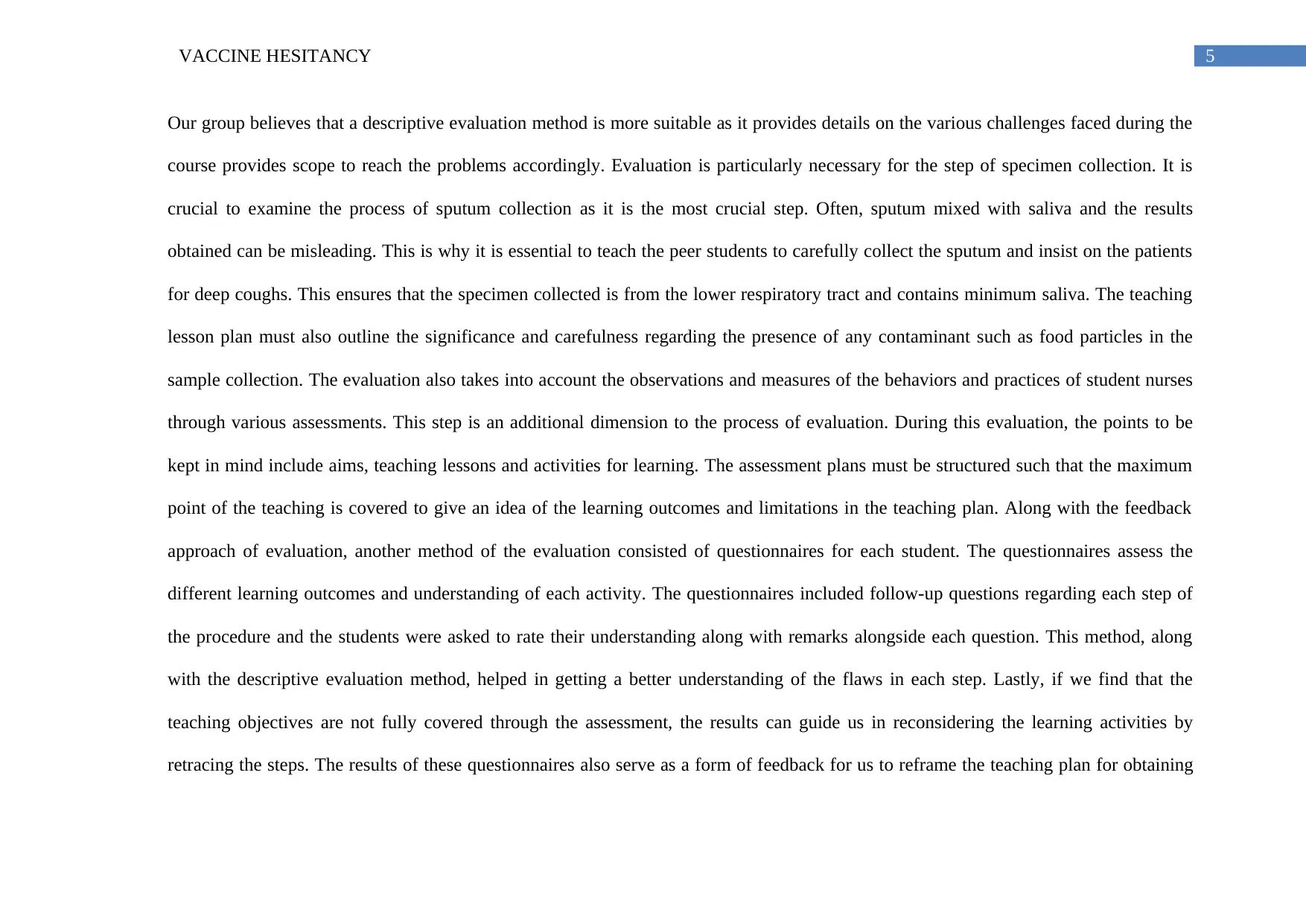
5VACCINE HESITANCY
Our group believes that a descriptive evaluation method is more suitable as it provides details on the various challenges faced during the
course provides scope to reach the problems accordingly. Evaluation is particularly necessary for the step of specimen collection. It is
crucial to examine the process of sputum collection as it is the most crucial step. Often, sputum mixed with saliva and the results
obtained can be misleading. This is why it is essential to teach the peer students to carefully collect the sputum and insist on the patients
for deep coughs. This ensures that the specimen collected is from the lower respiratory tract and contains minimum saliva. The teaching
lesson plan must also outline the significance and carefulness regarding the presence of any contaminant such as food particles in the
sample collection. The evaluation also takes into account the observations and measures of the behaviors and practices of student nurses
through various assessments. This step is an additional dimension to the process of evaluation. During this evaluation, the points to be
kept in mind include aims, teaching lessons and activities for learning. The assessment plans must be structured such that the maximum
point of the teaching is covered to give an idea of the learning outcomes and limitations in the teaching plan. Along with the feedback
approach of evaluation, another method of the evaluation consisted of questionnaires for each student. The questionnaires assess the
different learning outcomes and understanding of each activity. The questionnaires included follow-up questions regarding each step of
the procedure and the students were asked to rate their understanding along with remarks alongside each question. This method, along
with the descriptive evaluation method, helped in getting a better understanding of the flaws in each step. Lastly, if we find that the
teaching objectives are not fully covered through the assessment, the results can guide us in reconsidering the learning activities by
retracing the steps. The results of these questionnaires also serve as a form of feedback for us to reframe the teaching plan for obtaining
Our group believes that a descriptive evaluation method is more suitable as it provides details on the various challenges faced during the
course provides scope to reach the problems accordingly. Evaluation is particularly necessary for the step of specimen collection. It is
crucial to examine the process of sputum collection as it is the most crucial step. Often, sputum mixed with saliva and the results
obtained can be misleading. This is why it is essential to teach the peer students to carefully collect the sputum and insist on the patients
for deep coughs. This ensures that the specimen collected is from the lower respiratory tract and contains minimum saliva. The teaching
lesson plan must also outline the significance and carefulness regarding the presence of any contaminant such as food particles in the
sample collection. The evaluation also takes into account the observations and measures of the behaviors and practices of student nurses
through various assessments. This step is an additional dimension to the process of evaluation. During this evaluation, the points to be
kept in mind include aims, teaching lessons and activities for learning. The assessment plans must be structured such that the maximum
point of the teaching is covered to give an idea of the learning outcomes and limitations in the teaching plan. Along with the feedback
approach of evaluation, another method of the evaluation consisted of questionnaires for each student. The questionnaires assess the
different learning outcomes and understanding of each activity. The questionnaires included follow-up questions regarding each step of
the procedure and the students were asked to rate their understanding along with remarks alongside each question. This method, along
with the descriptive evaluation method, helped in getting a better understanding of the flaws in each step. Lastly, if we find that the
teaching objectives are not fully covered through the assessment, the results can guide us in reconsidering the learning activities by
retracing the steps. The results of these questionnaires also serve as a form of feedback for us to reframe the teaching plan for obtaining
⊘ This is a preview!⊘
Do you want full access?
Subscribe today to unlock all pages.

Trusted by 1+ million students worldwide
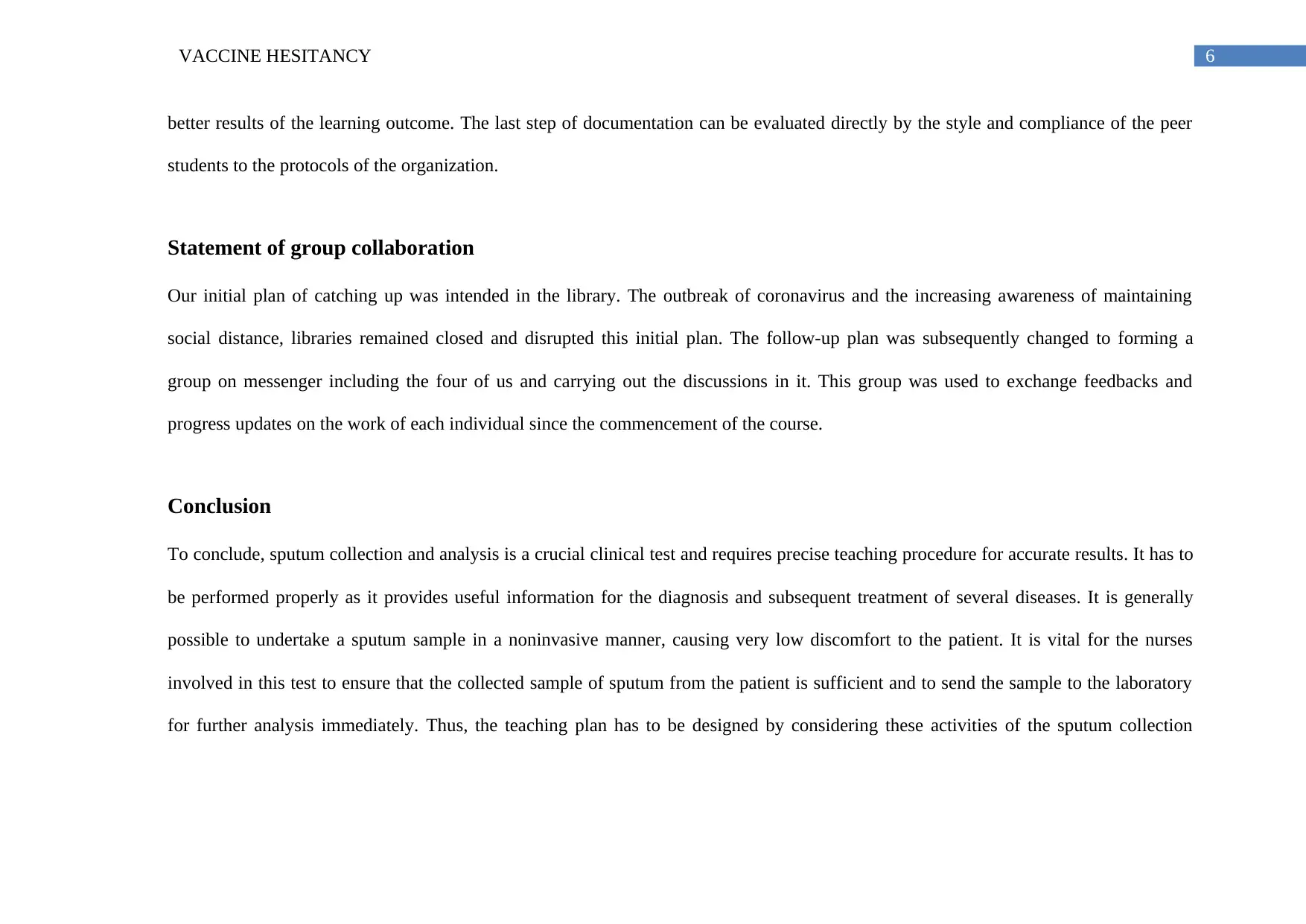
6VACCINE HESITANCY
better results of the learning outcome. The last step of documentation can be evaluated directly by the style and compliance of the peer
students to the protocols of the organization.
Statement of group collaboration
Our initial plan of catching up was intended in the library. The outbreak of coronavirus and the increasing awareness of maintaining
social distance, libraries remained closed and disrupted this initial plan. The follow-up plan was subsequently changed to forming a
group on messenger including the four of us and carrying out the discussions in it. This group was used to exchange feedbacks and
progress updates on the work of each individual since the commencement of the course.
Conclusion
To conclude, sputum collection and analysis is a crucial clinical test and requires precise teaching procedure for accurate results. It has to
be performed properly as it provides useful information for the diagnosis and subsequent treatment of several diseases. It is generally
possible to undertake a sputum sample in a noninvasive manner, causing very low discomfort to the patient. It is vital for the nurses
involved in this test to ensure that the collected sample of sputum from the patient is sufficient and to send the sample to the laboratory
for further analysis immediately. Thus, the teaching plan has to be designed by considering these activities of the sputum collection
better results of the learning outcome. The last step of documentation can be evaluated directly by the style and compliance of the peer
students to the protocols of the organization.
Statement of group collaboration
Our initial plan of catching up was intended in the library. The outbreak of coronavirus and the increasing awareness of maintaining
social distance, libraries remained closed and disrupted this initial plan. The follow-up plan was subsequently changed to forming a
group on messenger including the four of us and carrying out the discussions in it. This group was used to exchange feedbacks and
progress updates on the work of each individual since the commencement of the course.
Conclusion
To conclude, sputum collection and analysis is a crucial clinical test and requires precise teaching procedure for accurate results. It has to
be performed properly as it provides useful information for the diagnosis and subsequent treatment of several diseases. It is generally
possible to undertake a sputum sample in a noninvasive manner, causing very low discomfort to the patient. It is vital for the nurses
involved in this test to ensure that the collected sample of sputum from the patient is sufficient and to send the sample to the laboratory
for further analysis immediately. Thus, the teaching plan has to be designed by considering these activities of the sputum collection
Paraphrase This Document
Need a fresh take? Get an instant paraphrase of this document with our AI Paraphraser
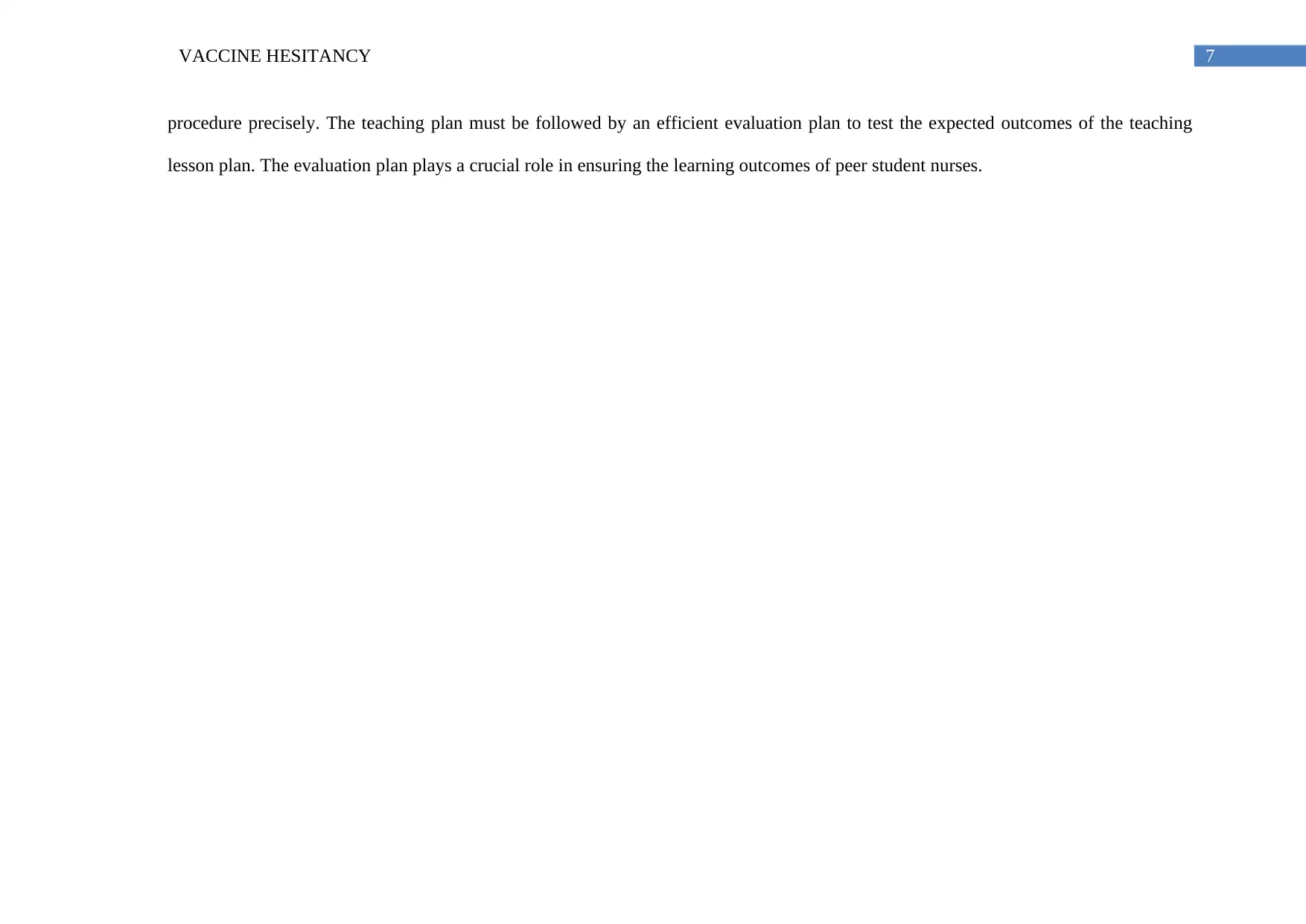
7VACCINE HESITANCY
procedure precisely. The teaching plan must be followed by an efficient evaluation plan to test the expected outcomes of the teaching
lesson plan. The evaluation plan plays a crucial role in ensuring the learning outcomes of peer student nurses.
procedure precisely. The teaching plan must be followed by an efficient evaluation plan to test the expected outcomes of the teaching
lesson plan. The evaluation plan plays a crucial role in ensuring the learning outcomes of peer student nurses.
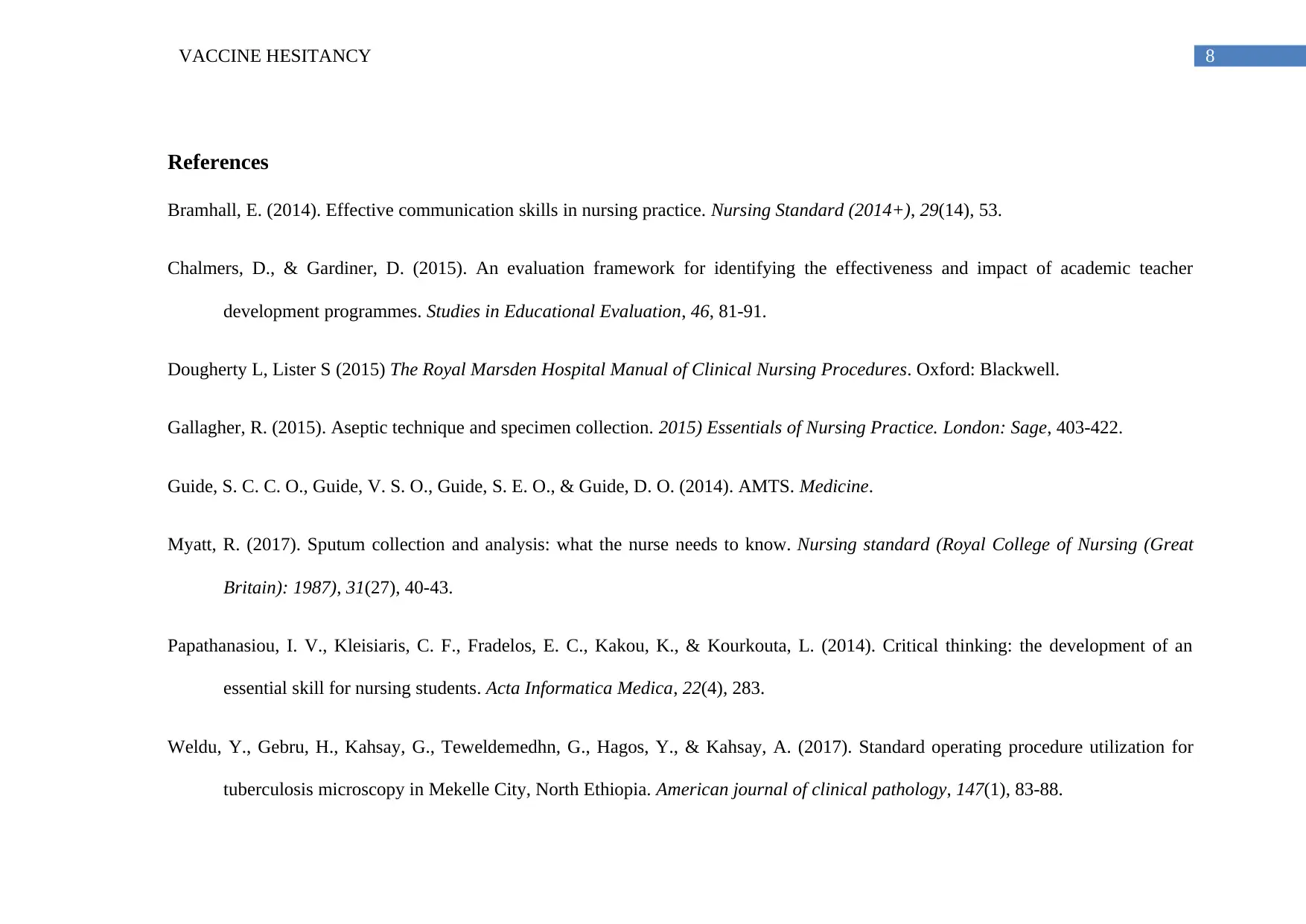
8VACCINE HESITANCY
References
Bramhall, E. (2014). Effective communication skills in nursing practice. Nursing Standard (2014+), 29(14), 53.
Chalmers, D., & Gardiner, D. (2015). An evaluation framework for identifying the effectiveness and impact of academic teacher
development programmes. Studies in Educational Evaluation, 46, 81-91.
Dougherty L, Lister S (2015) The Royal Marsden Hospital Manual of Clinical Nursing Procedures. Oxford: Blackwell.
Gallagher, R. (2015). Aseptic technique and specimen collection. 2015) Essentials of Nursing Practice. London: Sage, 403-422.
Guide, S. C. C. O., Guide, V. S. O., Guide, S. E. O., & Guide, D. O. (2014). AMTS. Medicine.
Myatt, R. (2017). Sputum collection and analysis: what the nurse needs to know. Nursing standard (Royal College of Nursing (Great
Britain): 1987), 31(27), 40-43.
Papathanasiou, I. V., Kleisiaris, C. F., Fradelos, E. C., Kakou, K., & Kourkouta, L. (2014). Critical thinking: the development of an
essential skill for nursing students. Acta Informatica Medica, 22(4), 283.
Weldu, Y., Gebru, H., Kahsay, G., Teweldemedhn, G., Hagos, Y., & Kahsay, A. (2017). Standard operating procedure utilization for
tuberculosis microscopy in Mekelle City, North Ethiopia. American journal of clinical pathology, 147(1), 83-88.
References
Bramhall, E. (2014). Effective communication skills in nursing practice. Nursing Standard (2014+), 29(14), 53.
Chalmers, D., & Gardiner, D. (2015). An evaluation framework for identifying the effectiveness and impact of academic teacher
development programmes. Studies in Educational Evaluation, 46, 81-91.
Dougherty L, Lister S (2015) The Royal Marsden Hospital Manual of Clinical Nursing Procedures. Oxford: Blackwell.
Gallagher, R. (2015). Aseptic technique and specimen collection. 2015) Essentials of Nursing Practice. London: Sage, 403-422.
Guide, S. C. C. O., Guide, V. S. O., Guide, S. E. O., & Guide, D. O. (2014). AMTS. Medicine.
Myatt, R. (2017). Sputum collection and analysis: what the nurse needs to know. Nursing standard (Royal College of Nursing (Great
Britain): 1987), 31(27), 40-43.
Papathanasiou, I. V., Kleisiaris, C. F., Fradelos, E. C., Kakou, K., & Kourkouta, L. (2014). Critical thinking: the development of an
essential skill for nursing students. Acta Informatica Medica, 22(4), 283.
Weldu, Y., Gebru, H., Kahsay, G., Teweldemedhn, G., Hagos, Y., & Kahsay, A. (2017). Standard operating procedure utilization for
tuberculosis microscopy in Mekelle City, North Ethiopia. American journal of clinical pathology, 147(1), 83-88.
⊘ This is a preview!⊘
Do you want full access?
Subscribe today to unlock all pages.

Trusted by 1+ million students worldwide
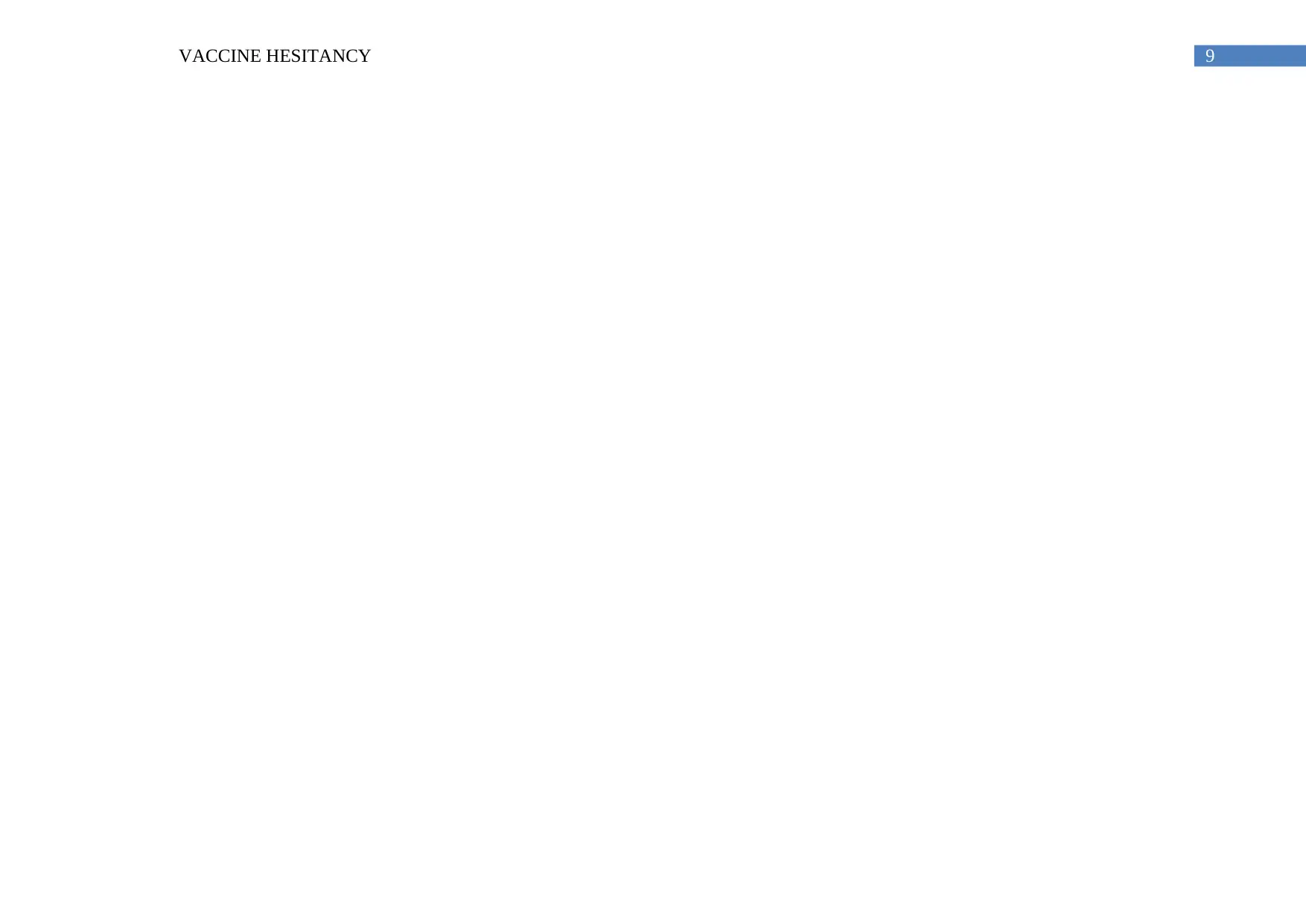
9VACCINE HESITANCY
1 out of 10
Your All-in-One AI-Powered Toolkit for Academic Success.
+13062052269
info@desklib.com
Available 24*7 on WhatsApp / Email
![[object Object]](/_next/static/media/star-bottom.7253800d.svg)
Unlock your academic potential
Copyright © 2020–2025 A2Z Services. All Rights Reserved. Developed and managed by ZUCOL.